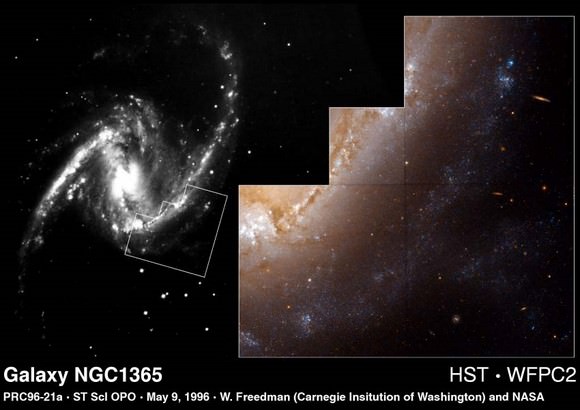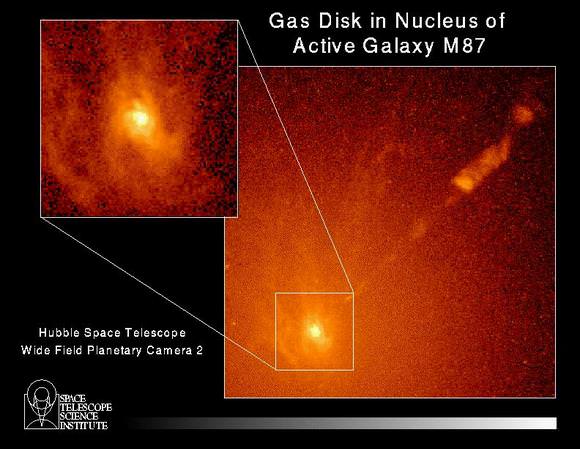[/caption]
For 15 years, the Hubble Space Telescope’s Wide Field and Planetary Camera 2 (WFPC2) has been churning out amazing and breathtaking images of our universe. But during the upcoming HST servicing mission, a new and improved version of Hubble’s main camera will replace the optical workhorse that has provided so many memorable and awe-inspiring images. WFPC2 was brought up on orbit to Hubble in December of 1993 to replace the original camera, outfitted with special optics to overcome the spherical aberration in Hubble’s main mirror. To honor the WFPC2, here are a few of the most memorable discoveries the camera has made.
Hubble Deep Field. Above is one of the most incredible images ever, the Hubble Deep Field. Over 10 consecutive days in December 1995, Hubble and the WFPC2 2 stared at a speck of sky no bigger than a grain of sand held at arm’s length. In that small patch of sky, more than 1,000 galaxies located billions of light-years away were revealed, each containing billions of stars. Our world and our galaxy suddenly seemed very small.

Pillars of Creation.
Imaged by the camera on April 1, 1995, the Eagle Nebula, 7,000 light-years away, is composed of dense, towering clusters of interstellar hydrogen, oxygen and sulfur, trillions of kilometers long. Emerging from these towers of cosmic material are stars being born.
“After we released the image during a press conference, CNN continued to cover the story live,” said Ed Weiler, acting assistant administrator for NASA’s Science Mission Directorate in Washington. “People felt compelled to call in with their reactions to this one picture…Some called it the pillars of creation. This picture touched Americans in a way I have never seen an astronomical picture do.”

Comet collision with Jupiter. WFPC2 gave the world a rare, stunning view of Comet Shoemaker-Levy 9 plunging into Jupiter in 1994. The images revealed the event in great detail, including ripples expanding outward from the impact.

Determining the age and rate of expansion of our universe. Our universe formed from a colossal explosion known as the Big Bang, and has been stretching apart ever since. Using WFPC2 to observe stars that vary periodically in brightness, astronomers were able to calculate the pace of this expansion to an unprecedented degree of error of 10 percent. The camera also played a leading role in discovering that the expansion of the universe is accelerating, driven by a mysterious force called “dark energy.” Together, these findings led to the calculation that our universe is approximately 13.7 billion years old.

Most galaxies harbor huge black holes. Before Hubble, astronomers suspected, but had no proof, that supermassive black holes lurk deep in the bellies of galaxies. The Wide Field and Planetary Camera 2, together with spectroscopy data from Hubble, showed that most galaxies in the universe do indeed harbor monstrous black holes up to billions of times the mass of our sun.
Source: JPL


I am so happy they will attempt the fix of this awesome scope so it can continue to work wonders until the next generation ST becomes operational. I always wanted redundant ST in case something happens with one of them.
Why is Spitzer running out of coolant so soon when Hubble happily goes on for so long? Does Hubble not need coolant to image non infra-red images?
I don’t think Hubble needs to be as cold as 3K
Simply stunning. The pillars of creation image directly inspired my choice of study and subsequent career. I still vividly remember the moment it was shown on TV – I was absolutely taken aback. I couldn’t get it out of my mind for weeks, and I haven’t been able to get astronomy and science out of my mind to this day since that moment.
It is the most beautiful astronomical image I have ever seen, and that includes any view I’ve had through the scope. It’s a funny thing to admit for an amateur astronomer, but true none-the-less.
I cannot wait to see what beauty the new suite of instruments lifts the veil on…
# Jon Says:
May 5th, 2009 at 10:21 pm
“Why is Spitzer running out of coolant so soon when Hubble happily goes on for so long? Does Hubble not need coolant to image non infra-red images?”
Spitzer images at infrared wavelengths. Any object not close to absolute zero temperature emits copiously in this region of the spectrum, so if Spitzer were not cooled, the infrared radiation from it’s own detector would drown out the signal of astronomical origin.
Hubble does not need to be cooled – it images in the visible range of the EM spectrum. Objects only emit visible radiation when they are very hot – hundreds of degrees, so Hubble can image quite happily at the ambient temperature of space in the region of it’s orbit..
Surely this instrument, the only working camera from Hubble we will have when it’s returned, belongs in the Smithsonian or some similar place of prestige.
@ Jon
Hubble does indeed also work in the infrared, but it’s the near infrared, very close to the optical part of the spectrum.
And the infrared part is big, several microns, compared to the optical part (~ 0,6 microns). And Spitzer works in a region, I think at about 10microns, where heat indeed becomes very important (as pointed out before).
Btw: Hopefully everything goes well with this shuttle mission and they launch on Monday smoothly….
This and in reference to the Constellation thread here, it is important to keep these devices in working order and replaced with improved versions. This is more important than keeping astronauts up on the moon.
Lawrence B. Crowell
Any IR optical system must be cooler than the objects or background it is looking at. Otherwise you are sending more IR radiation out than what you are trying to detect. An analogue might be seen in why we keep the dome lights off in the car at night as we drive.
Lawrence B. Crowell